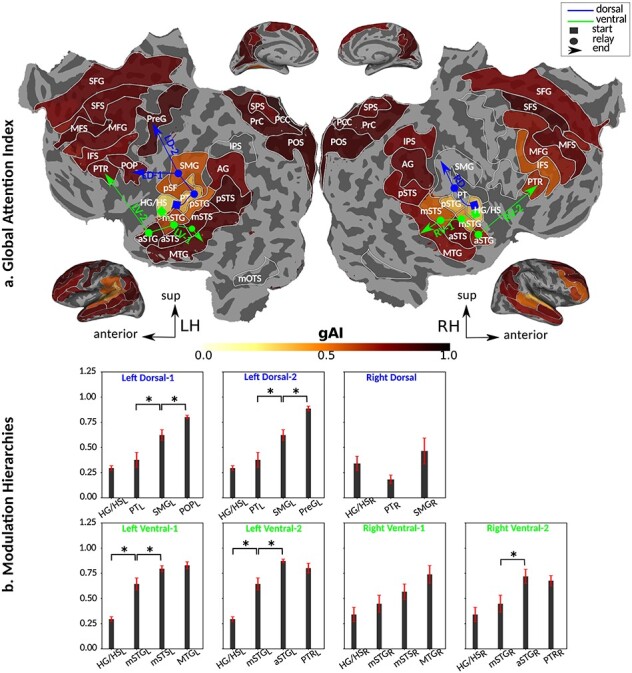Figure 7 .

Global attentional modulation. (a) “Global attention index.” To quantify overall modulatory effects on selectivity across all examined feature levels, global attentional modulation ( ) was computed by summing spectral, articulatory, and semantic attention indices (see Materials and Methods).
) was computed by summing spectral, articulatory, and semantic attention indices (see Materials and Methods).  is in the range of [−1,1] and a value of zero indicates no modulation. Colors indicate significantly positive
is in the range of [−1,1] and a value of zero indicates no modulation. Colors indicate significantly positive  averaged across subjects (see legend; see Supplementary Fig. 10 for bar plots of
averaged across subjects (see legend; see Supplementary Fig. 10 for bar plots of  across cortex). Dorsal and ventral pathways are shown with blue and green lines, respectively: left dorsal-1 (LD-1), left dorsal-2 (LD-2) and right dorsal (RD), left ventral-1 (LV-1), left ventral-2 (LV-2), right ventral-1 (RV-1) and right ventral-2 (RV-2). Squares mark regions where pathways begin; arrows mark regions where pathways end; and circles mark relay regions in between. (b) “Modulation hierarchies.” Bar plots display
across cortex). Dorsal and ventral pathways are shown with blue and green lines, respectively: left dorsal-1 (LD-1), left dorsal-2 (LD-2) and right dorsal (RD), left ventral-1 (LV-1), left ventral-2 (LV-2), right ventral-1 (RV-1) and right ventral-2 (RV-2). Squares mark regions where pathways begin; arrows mark regions where pathways end; and circles mark relay regions in between. (b) “Modulation hierarchies.” Bar plots display  (mean ± SEM across subjects) along LD-1, LD-2, RD, LV-1, LV-2, RV-1 and RV-2, shown in separate panels. Significant differences in
(mean ± SEM across subjects) along LD-1, LD-2, RD, LV-1, LV-2, RV-1 and RV-2, shown in separate panels. Significant differences in  between consecutive ROIs are marked with brackets (P < 0.05, bootstrap test; see Supplementary Fig. 11 for single-subject results). Significant gradients in
between consecutive ROIs are marked with brackets (P < 0.05, bootstrap test; see Supplementary Fig. 11 for single-subject results). Significant gradients in  are
are  in LD-1,
in LD-1,  in LD-2,
in LD-2,  in LV-1,
in LV-1,  in LV-2, and
in LV-2, and  in RV-2. In the LH,
in RV-2. In the LH,  gradually increases from early auditory regions to higher-order regions across the dorsal and ventral pathways. Similar patterns are also observed in the right hemisphere, although the gradients in
gradually increases from early auditory regions to higher-order regions across the dorsal and ventral pathways. Similar patterns are also observed in the right hemisphere, although the gradients in  are less consistent across subjects.
are less consistent across subjects.
